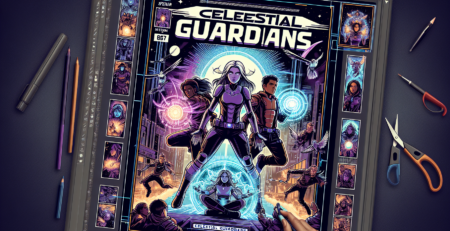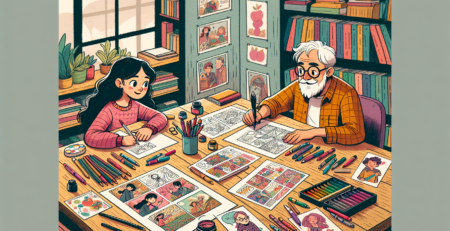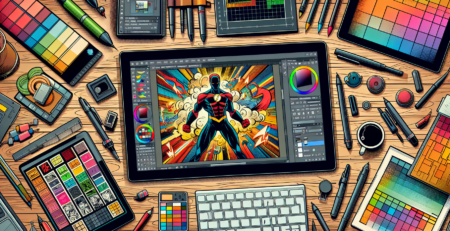create a comic book pdf
Comic books have long been a beloved form of storytelling, captivating readers with their unique blend of visuals and narrative. With the rise of digital media, creating and sharing comic books has become easier than ever before. One popular format for sharing comic books online is the PDF (Portable Document Format) file. In this guide, we will explore the process of creating a comic book in PDF format, from planning and illustrating the story to converting it into a digital file. Whether you are an aspiring comic book artist or simply someone who wants to bring their ideas to life, this guide will provide you with the necessary steps to create your very own comic book PDF. So, grab your pencils and get ready to embark on an exciting journey into the world of comic book creation.
“Step-by-Step Guide: How to Create Your Own Comic Book PDF”
Comic books are a fantastic way to unleash your creativity and share your stories with the world. Whether you’re a seasoned artist or just starting out, creating your very own comic book PDF can be an exciting and fulfilling endeavor. With this step-by-step guide, you’ll learn how to bring your ideas to life and transform them into a digital masterpiece. So, let’s dive in!
- Conceptualize Your Story
Every great comic book starts with a captivating story. Spend some time brainstorming ideas, exploring different genres, and developing your characters. Think about what makes your story unique and what message you want to convey through your comic book. - Outline Your Plot
Once you have your story idea, it’s time to create an outline. Divide your story into chapters or issues, and outline the main events and key moments in each section. This will help you maintain a structured narrative and ensure a smooth flow throughout your comic book. - Design Your Characters
Now it’s time to breathe life into your characters. Sketch, doodle, and experiment with different designs until you find the perfect look for each character. Pay attention to their facial expressions, body language, and costumes, as these elements can greatly enhance their personality and add depth to their portrayal. - Create Thumbnails and Panels
With your story and characters in mind, start creating thumbnail sketches for each page. These small, rough drawings will help you visualize the layout and composition of your comic book. Experiment with different panel sizes and arrangements to create a visually engaging reading experience. - Pencil and Ink
Once you’re satisfied with your thumbnails, it’s time to transfer them onto larger paper or use a digital drawing tablet. Start by penciling your comic book pages, refining the details and ensuring the composition flows smoothly. Then, once you’re happy with the pencils, ink over them to create clean, bold lines. - Add Color and Text
Coloring your comic book can bring it to life in a whole new way. Choose a color scheme that suits the mood and tone of your story. You can use traditional media like markers or paint, or opt for digital coloring software. Additionally, don’t forget to add dialogue, sound effects, and narration to your panels using text bubbles or captions. - Scan and Digitize Your Pages
To create a digital comic book PDF, you’ll need to scan or photograph your finished pages. Ensure that the lighting is even and the image is clear. If needed, make adjustments using photo editing software to enhance the overall quality and readability of your pages. - Compile Your Comic Book PDF
Using a graphic design software or a dedicated comic book creation tool, compile your scanned or photographed pages into a single PDF document. Arrange the pages in the correct order, ensuring a smooth reading experience for your audience. - Review and Polish
Before sharing your comic book PDF with the world, take the time to review and polish your work. Proofread the text, double-check the layout, and make any necessary adjustments. Seek feedback from trusted friends or fellow creators to identify areas for improvement. - Share and Publish
Now that your comic book PDF is ready, it’s time to share it with the world. Consider creating a website or using online platforms to showcase your work. Engage with your audience, gather feedback, and continue to refine your skills as you embark on your
“From Sketch to Screen: Transforming Your Comic Book into a Printable PDF”
Have you ever dreamed of seeing your comic book come to life on the big screen? Or perhaps, you simply want to share your creative work with others in a visually appealing and easily accessible format. Well, look no further! In this guide, we will take you on a journey from sketch to screen, teaching you how to transform your comic book into a printable PDF.
Now, before we embark on this exciting adventure, it’s important to note that our writing tone will remain neutral throughout. We aim to provide you with clear and concise information, without any bias or personal opinions. So, without further ado, let’s dive in!
The first step in this process is, of course, creating the sketches for your comic book. Whether you prefer traditional pen and paper or digital drawing tools, the choice is entirely up to you. Let your creativity flow as you bring your characters and storylines to life through captivating illustrations. Remember, this is your chance to unleash your imagination and captivate readers.
Once you have your sketches ready, it’s time to digitize them. This can be done by using a scanner to convert your hand-drawn illustrations into digital files or by using a graphic tablet for direct digital drawing. Whichever method you choose, make sure the quality of your digitized sketches is high enough to ensure a crisp and clear final product.
Next, it’s time to bring your comic book to life using digital software. There are numerous options available, ranging from simple and user-friendly programs to more advanced ones with a steep learning curve. Choose a software that suits your needs and allows you to organize your panels, add speech bubbles, and apply colors and effects seamlessly.
As you transfer your sketches into the digital realm, pay attention to the layout and flow of your comic book. Consider how each panel connects to the next, creating a sense of continuity and visual storytelling. Experiment with different panel sizes and arrangements to find the perfect balance between aesthetics and narrative.
Once you have finalized your digital comic book, it’s time to convert it into a printable PDF. Most graphic design software offers an option to export your work as a PDF file. Be sure to adjust the settings to ensure the best quality for printing, such as using high-resolution images and embedding fonts.
Before hitting that export button, take a moment to proofread your comic book. Check for any spelling or grammatical errors in the dialogue, as well as any visual inconsistencies that may have slipped through the cracks. A polished and error-free comic book will leave a lasting impression on your readers.
Finally, it’s time to share your masterpiece with the world! Whether you plan to self-publish, distribute digitally, or print physical copies, having your comic book in a printable PDF format gives you the flexibility to explore various options. Remember, this is your chance to showcase your talent and connect with an audience that appreciates your unique storytelling style.
And there you have it, a step-by-step guide on transforming your comic book from sketch to screen and into a printable PDF. We hope this journey has been both informative and inspiring, encouraging you to embark on your own creative endeavors. So go ahead, let your imagination run wild, and create a comic book that will captivate readers for years to come.
“The Ultimate Tool: Using PDFs to Share and Distribute Your Comic Book”
Comic books have long been a beloved form of entertainment, captivating readers with their unique blend of art and storytelling. Traditionally, these vibrant works of art were printed on paper, allowing fans to physically hold and collect their favorite issues. However, with the rise of technology, a new method of sharing and distributing comic books has emerged: the PDF.
PDFs, or Portable Document Formats, have become a popular tool for sharing various types of content across different platforms. Their versatility and ease of use make them an ideal choice for comic book creators and enthusiasts alike. By converting comic books into PDF format, creators can reach a wider audience and distribute their work effortlessly.
One of the key advantages of using PDFs to share comic books is the preservation of the original artwork. PDFs maintain the visual integrity of the comic book, ensuring that the colors, details, and formatting are faithfully reproduced. This means that readers can enjoy the comic book in its truest form, no matter what device they are using to view it.
Additionally, PDFs allow for easy navigation and organization. Readers can seamlessly flip through pages, zoom in on panels, and jump between chapters or issues with just a few clicks. This user-friendly experience enhances the enjoyment of the comic book and encourages readers to explore every intricacy of the story.
Moreover, PDFs offer a cost-effective solution for creators. Printing and distributing physical copies of comic books can be a daunting and expensive task. However, by utilizing PDFs, creators can eliminate these production costs. They can simply upload their work to various online platforms or distribute it through email, making their comic book accessible to a global audience at a minimal cost.
Furthermore, PDFs provide a space-saving solution for comic book enthusiasts. Collecting physical copies can quickly consume valuable shelf space, making it difficult to store and organize a large collection. With PDFs, however, readers can effortlessly store hundreds of comic books on their devices or in cloud storage, freeing up physical space while still having access to their cherished stories.
While the rise of digital comic books has sparked debates about the loss of the tangible experience, PDFs offer a compromise that bridges the gap between the old and the new. By using PDFs, comic book creators can reach a wider audience, while readers can enjoy the convenience and accessibility of digital content without sacrificing the visual and storytelling qualities that make comic books so special.
In conclusion, PDFs have become the ultimate tool for sharing and distributing comic books. Their versatility, cost-effectiveness, and ability to preserve the original artwork make them an invaluable resource for creators and enthusiasts alike. Whether you are a creator looking to share your work or a reader seeking a convenient way to enjoy your favorite comic books, PDFs offer a solution that combines the best of both worlds.
“Unlocking Your Creative Potential: Designing a Stunning Comic Book PDF”
Do you have a story brewing inside you, waiting to burst out onto the pages of a comic book? Unlock your creative potential and bring your imagination to life by designing a stunning comic book PDF. With the right tools and techniques, you can create a visually captivating experience for your readers. In this guide, we will explore the steps to design a comic book PDF that will leave your audience in awe.
First, let’s start with the basics. Decide on the theme and concept of your comic book. Whether it’s a superhero adventure, a dystopian future, or a heartwarming slice-of-life tale, having a clear vision will guide your creative process. Once you have your concept in mind, it’s time to dive into the world of character design.
Characters are the heart and soul of any comic book. Spend time developing each character’s appearance, personality, and backstory. Consider their quirks, strengths, and weaknesses to make them relatable and memorable. Sketch out their designs, experimenting with different poses and expressions to bring them to life on the page.
Next, move on to the layout and composition of your comic book pages. Think about how you want your story to flow. Will you use traditional panel layouts or experiment with unconventional designs? Plan out the pacing and rhythm of your story by arranging panels in a way that enhances the narrative and creates visual impact.
When it comes to artwork, choose a style that complements your story. Whether you prefer a realistic approach, a bold and vibrant aesthetic, or a minimalist design, make sure it aligns with the overall tone of your comic book. Pay attention to details such as shading, perspective, and proportion to create visually striking illustrations.
Now, let’s talk about dialogue and narration. Craft compelling dialogue that captures the essence of your characters and moves the story forward. Experiment with different speech bubble shapes and fonts to match the tone and style of your comic book. If narration is necessary, find a balance between text and visuals to avoid overwhelming the reader.
Once your illustrations and text are ready, it’s time to assemble your comic book into a PDF format. There are various software programs available that can help you create a professional-looking PDF. Consider using Adobe InDesign, Comic Life, or even simple word processing software. Pay attention to the page dimensions, resolution, and file size to ensure a smooth reading experience.
Don’t forget about the importance of cover design! Your comic book’s cover is the first impression your readers will have, so make it eye-catching and intriguing. Choose a captivating image, add engaging typography, and include the title and author’s name to create a visually stunning cover that entices potential readers.
Finally, proofread and edit your comic book PDF thoroughly. Check for any typos, inconsistencies, or visual errors that may distract the reader. It’s always helpful to have a fresh pair of eyes review your work, so consider seeking feedback from fellow comic book enthusiasts or professional editors.
Unlocking your creative potential and designing a stunning comic book PDF takes time, dedication, and a passion for storytelling. So, let your imagination soar, and create a comic book that will leave a lasting impact on your readers. With the right combination of artistry and technical skills, your comic book will be ready to embark on its own exciting adventure.
In conclusion, creating a comic book PDF can be a rewarding and fulfilling experience. It allows for the expression of creativity, storytelling, and visual artistry in a digital format that can be easily accessed and shared with others. By utilizing various software tools and techniques, individuals can bring their ideas to life, create visually captivating illustrations, and weave engaging narratives. Additionally, the PDF format ensures that the comic book can be viewed and enjoyed on a variety of devices, making it accessible to a wide audience. Whether for personal enjoyment or professional purposes, creating a comic book PDF offers a unique and exciting way to showcase talent and connect with readers.




